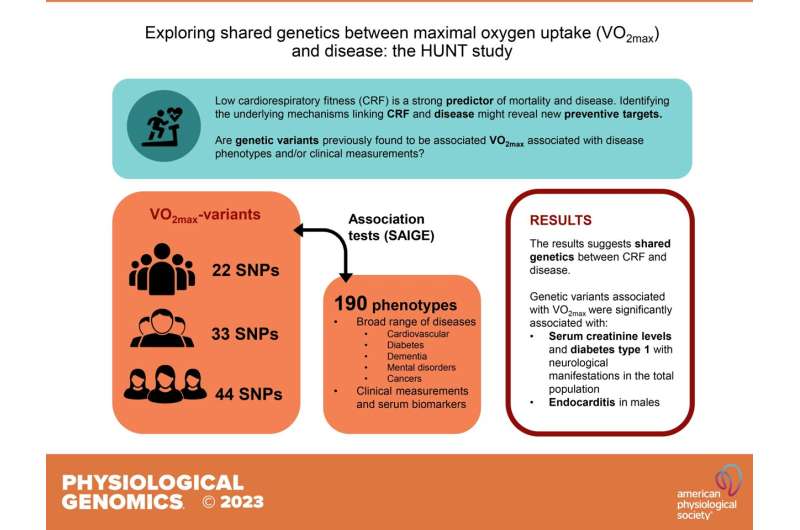This article has been reviewed according to Science X's editorial process and policies. Editors have highlighted the following attributes while ensuring the content's credibility:
fact-checked
trusted source
proofread
Genetic connection between aerobic fitness and disease is not what you'd expect

New research examines the complex relationship between gene variants, cardiorespiratory fitness and the development of chronic disease. The study is published ahead of print in Physiological Genomics. It was chosen as an APSselect article for October.
Researchers examined data from the Trøndelag Health Study (HUNT). HUNT is a long-term analysis of the population of the Norwegian county of Trøndelag. HUNT includes both questionnaire responses and clinical data. Its data can also be linked to hospital disease classification codes from local hospitals.
The researchers built on a previously published first-of-its-kind genome-wide association study that looked at a subset of HUNT participants who also took part in tests of their maximum oxygen consumption while exercising (VO2max). VO2max is a common measure of aerobic fitness, with higher values indicating a lower disease risk.
In the previous study, researchers identified gene variations associated with VO2max. The current research looked at the gene variations related to aerobic fitness from the previous study and identified if they were associated with the risk of different diseases, including cardiovascular diseases, diabetes, mental disorders and cancer. They also tested whether the gene variations were associated with observable traits (called phenotypes) or biomarkers.
The research team studied 22 previously identified gene variations for associations with 189 phenotypes in a population of more than 64,000 people, including more than 30,000 each of women and men. In the total population, they found that three of the VO2max gene variants were associated with blood creatinine levels—a common indicator of kidney health—and one variant was associated with Type 1 diabetes with nerve damage.
Four more gene variants were associated with endocarditis—which is the inflammation of the inner lining of the heart—specifically in the male population. Less certain findings showed that genetic variants of high VO2max might contribute to body mass index, healthier HDL cholesterol and lower resting heart rate.
The researchers had "speculated that genotypes underlying high VO2max could also be underlying a reduction in disease risk," as high VO2max is beneficial for your health. However, their findings showed the opposite. The increased creatine levels, Type 1 diabetes and endocarditis phenotypes were all associated with gene variants that had been associated with increased VO2max. That means these gene variants were associated with better cardiorespiratory fitness and also with serious health problems. "The exact mechanisms underlying these observations might be complex and will require further research," the authors concluded.
More information: Ada N. Nordeidet et al, Exploring shared genetics between maximal oxygen uptake and disease: the HUNT study, Physiological Genomics (2023). DOI: 10.1152/physiolgenomics.00026.2023

















